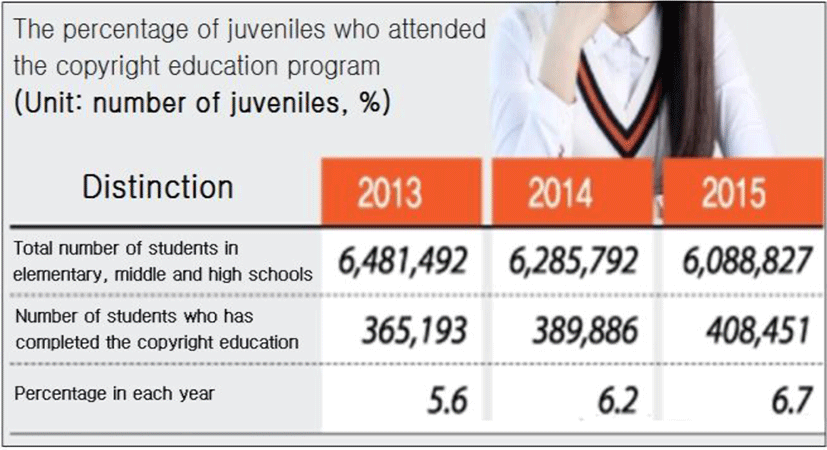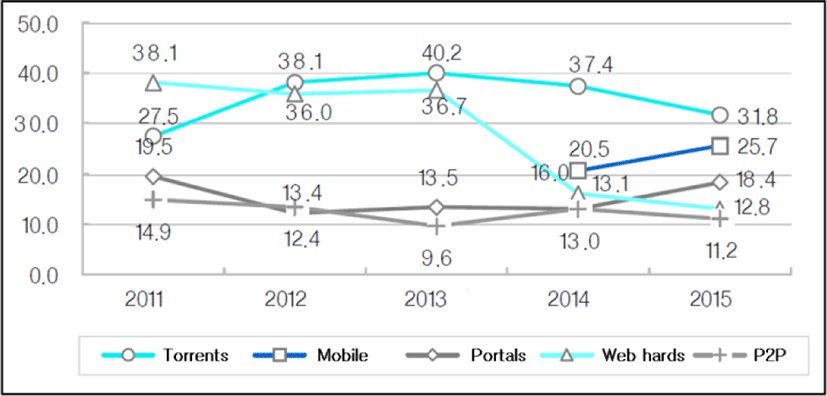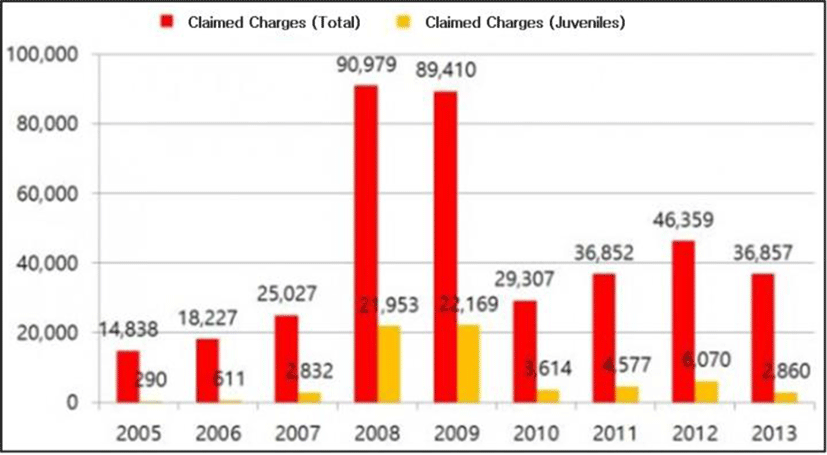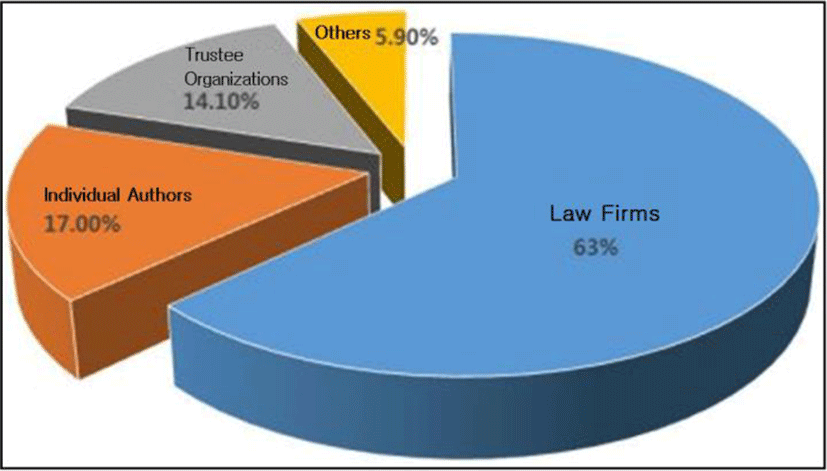I. INTRODUCTION
The first round of Free Trade Agreement (FTA) negotiations was brought to a close in 2006. At the time, the ROK delegation assumed a prudent position in response to the demand to revise copyright law by the USA through the document titled ‘The prospect and measures for the ROK-USA FTA copyrights negotiations’ [1]. Although the Korean delegation believed that the demand was rather immoderate, they accepted most parts of the demand considering the global trend and national interest. Some of the major issues in the US’s demand that would affect secondary school students were the introductions of ‘offense indictable without complaint’, ‘extension of copyright protection periods, and ‘reinforcement of investigators for copyright-related violations’. Following the negotiations, actual protective measures were put into action along with the revision of related laws at the National Assembly.
As a result, the number of lawsuits has increased, in particular by law firms. According to the Ministry of Culture, Sports and Tourism, the number of lawsuits concerning copyrights violations by teenagers had decreased from 25,533 cases (2009) to 3,614 (2010) and 1,556 (2015) cases after the implementation of the revised laws Figure 1 but it was pointed out that education regarding copyrights protection should be strengthened for them. The Korea Copyright Commission claims that the number of high school students who responded that they had received some kind of copyright-related educations accounted for only 18.7% of the total responders (Survey on the elementary and secondary school students’ attitude toward copyrights, the Korea Copyright Commission, 2015).

While the number of participating teenagers in ‘The Youth Copyrights Experience Course’ and ‘Copyright Education for the Youths’ has increased, last year’s (2015) total participants were just 408,451, just 6.7% of entire elementary and secondary students (6,088,827). The commission emphasized the importance of such education, saying, “According to the last year’s attitude survey, the perception (consciousness) index of those who have participated the copyright educations at least once was higher than that of those who did not.”
In the past, police and prosecutors investigated and prosecuted some of the adult heavy uploaders1 of socially unacceptable materials but the laws and guidelines have been revised after the FTA negotiations of 2006. The nonsuit system for teenagers [2] which has been implemented since March of 2009 will be abolished by the end of February, 2017 and after that period, teenagers, including secondary students, will be subjected to police investigation following accusations, and if the case is forwarded to the prosecution, they could be charged depending on their extent of crimes and reflections on themselves. Meanwhile, a guideline of conditional non-indictment3 is being prepared for those who were not formally indicted such that it is imperative to broaden teenagers’ understanding and strengthen teachers’ guidance in the front-line educational fields. Thus, this study attempts to study the ethical issues in protecting the copyrights of digitized contents and find practical alternative solutions.
II. THEORETICAL BACKGROUND
Similar to ownership, the copyright is considered as a legal right [4] to one’s own expressions. The digital works refer to the cultural contents (e.g., musics, videos, pictures or photos, and texts, etc.) which have been created and exist in digitized forms. Different from analog materials, digital materials can be copied identical to the originals so that their risk of infringing the copyrights is high. Meanwhile, the author’s property rights mean the economic rights one’s own works, such as the reproduction, performing, broadcasting, transmission, exhibition, distribution, and derivative works production rights. All of these 7 kinds of rights are the control rights similar to real rights, which can be subjected to transfer or inheritance and also be claimed [5]. Moreover, the author’s property right is an exclusive right to the author’s own works, but most of time, authors allow others to use their work(s) to get paid.
According to the revised Korean copyright law (June 30th, 2011), one’s ‘works’ are defined as the creations which represent human ideas or emotions (Article II, section I) and cinematographic works are creations in which continuous images (with or without audio) are contained such that they can be watched or heard by playing machines or electronic devices (Article II, Section XIII). And Article II, Section XVI states that the works of computer programs are the creations represented with the series of commands used directly or indirectly within the devices that possess data processing capability (i.e., computers) to attain certain results [6].
This system concludes the case without any legal investigation if the teenager is a first offender of copyright violation committed by uploading illegal copies of video or music files. The system has been in effect since March of 2009 because of high suicide rates between the year 2006 to 2008 but is scheduled to be abolished next year (Fed, 2016).
This system offers a one-time-only chance to attend the copyright education course for the copyright offenders who do not have any previous convictions and accidentally violated the law. With the judgement of the prosecutor, indictment will be suspended. The education is commissioned to the Korea Copyright Commission by the Prosecutors’ Office and carried out eight hours a day. The system originally targeted cases involving teenagers but starting from March, 2009, it was applied nationally including the adults.
Traditionally, 3Rs (i.e., Reading, wRiting and aRithmetic) have been emphasized in the USA education system [8, 18, 23] but the significance of the computer education is growing due to the development of information technology and ever increasing interest in computer education.
The characteristic of the USA’s high school curriculum system is that the nation does not make national level curriculums but each state runs their own specialized educational systems. The same goes for computer education so that the national education project such as the establishment of the nationwide school network is carried out at national level, but curriculum development is exercised at each school district of respective states, where independent education is performed (Young-Kwon Bae, Jin-Sook Lim, Tae-Wuk Lee [18]). Most states include computer subjects in science and technology related courses rather than treating them separately [1].
This differs from us (Republic of Korea), since national level curriculums are not provided in USA—each state employs the technical and computer science standards suggested by the organizations like ISTE (International Society for Technology in Education and ACM (Association for Computing Machinery) or companies such as Microsoft high school Curriculum, Cisco high school Curriculum, IBM high school Curriculum and Apple high school Curriculum) when they prepare computer education-related curriculums [21-25]. Although each school conducts distinct education, it would help to understand the USA computer education system if we examine curriculums offered by ACM or other companies preferred by many states:
First, students need to be prepared to understand fundamental characteristics of computer science and where it holds its position in our modern society. Second, students should understand both the principles and functions of computer science. Third, students should be able to utilize the functions of computer science, especially algorithmic thinking when they are involved in problem solving activities in different subjects. And finally, advanced education should be offered to the students who have gifts or shown interests [28-29].
A summary of ‘A study of the United Kingdom (UK) computer curriculum’ by Mi-Ryang Kim [17] is as follows: The computer courses in the early computer education system of the UK were also non-independently established and the learning contents were merely about information technology described in the technology-related subject which was just one of 10 relevant basic courses. However, technology was regarded as a major course along with mathematics, science and English and its importance had been emphasized in the national curriculums.
In the UK, the infrastructure for computer education has been prepared by establishing the national learning network and by adopting ICT as an independent subject, they set the condition to be able to accomplish systemic education for all students up to 9th grade [23-29]. Information technology is not limited to ICT courses and the student can also access independently established ICT education even after 9th grade by choice. They provide the systemic and active support for ICT education at the political level and such institutional/financial support is becoming a foundation for fostering outstanding individuals who are supposed to lead the UK’s information-oriented society.
Under such a social background, Japan has started the movement ‘Building the schools that have more relaxation but distinct characteristics’ and a new curriculum which aims to cultivate students’ competence in life has been revised and announced for elementary and middle schools (1998) and for high schools (1999), followed by all-out implementation (2002) for elementary and middle schools and for high schools (2003), adapting to the order of newly enrolled. The “information subject” was designated as a compulsory subject and established in the high school curriculum. In doing so, students may develop in a manner that enables them to independently respond to the information society by enhancing their abilities to determine and analyze information using computers [29].
A summary of the study relayed to the India computer curriculum Mi-Ryang Kim [17] is as follows: India has achieved recognition as an IT power in fact as well as in name. It produces about 30% of IT professionals in Silicon Valley and holds the 2nd place following US in the world software market. Moreover, its competency is recognized widely so that 185 out of 500 Fortune companies entrust their software outsourcing work to it. Although information infrastructure in India is comparatively worse than that of most other advanced countries, the country is expected to overcome such a disadvantage with the development of its software-oriented IT industry. Excellent IT human resources, STP (Software Technology Parks) plan and strong software industry development policies largely contribute to the recognition of the India as the IT power [24, 25, 29].
India’s computer education, which has been enhanced much further than in any other country, is the foundation of its growth. Compared to the fact that other nations are giving weight to the utilization of computer functions, India’s computer curriculums emphasize algorithms and applied mathematics. Also, it’s possible to observe that they are introducing programming languages in early stages but lessons for software applications and network use come in later compare to the other nations.
In our country, we encounter programming languages when in colleges but in India, they can be learned at the elementary school level through regular curriculums, with C++ or Java languages introduced at middle and high schools, revealing that students in India are receiving high-level programming education [23, 25, 27, 29].
III. Ethical Study on the Protection of Author’s Digital Property Rights for Secondary School Students
As mentioned above, copyright violations have been punished mainly for works related to computer programs in offline situations originally, and the relevant laws at the time had some aspect of protecting the author’s honor, rather than focusing on the punishment itself. However, through changes over time, the area of copyright has expanded to include the author’s digital property rights. The idea of copyright protection seems to be evolving from just pursuing economic gains to prioritizing indemnifications for the use of one’s works. That is, as the best measure of protection, it was thought that it was more important to respect author’s honor by clarifying the boundary of ownership but such an idea is now changing its direction to protecting author’s creativity by calculating and paying the royalties for the his/her creative works [7].
Today, most secondary school students in the ROK do not have to buy two to three months old lecture contents when they study at the private educational institutes located in a famous Daechi-dong area. Moreover, they would not need to purchase CDs to listen to a month old popular music or go to cinemas to watch recently released movies. This is because they can easily obtain such digital works (or digital contents) through today’s P2P services, portals or cyber cafes. Following the increase in the number of databases on these internet services in addition to continuously increasing internet speeds, the students can attain digital works more conveniently and upload or download individually to gain more user points on the P2P sites, leaving no traces of knowledge.
As a result, they are now frequently sued by law firms. Similar cases are occurring on the online social network services where copied music or images are freely uploaded or downloaded unconsciously. Such offenses are subjected to complaints, and while the investigative authorities are not aggressively clamping down on the cases currently, after the finalization of the ROK-US FTA agreement, the offenders can be prosecuted without complaint and even the nonsuit system for teenagers will be abolished. Furthermore, increased investigative manpower will lead to more prosecution of teenagers who would be summarily or formally indicted and punished with a fine or jail term - otherwise, with conditional suspension subjected to participation in educational courses. Figure 2. shows the percentage of illegal music copies in each different distribution channel dating from 2011 to 2015.

As for the effects of household incomes of the users, nearly 410 million tunes were illegally enjoyed by those with the income between 2 to 3.99 million won, whereas approx. 350 million and 240 million tunes were downloaded or listened by the users with the income between 4 to 5.99 million won and over 6 million won, respectively. Those with the income level under 2 million won used about 10 million tunes, which was relatively a small number compared to the heavy users of higher incomes. Also, illegal circulation was mostly conducted among the users with the income between 2 to 3.99 million won through all the distribution channels.
Examining illegal users’ occupations, white-collar workers and students were the major users of illegal music tunes accounting about 530 million and 380 million uses in total illegal number of uses. The former preferred to use P2P, Portals, web hards and torrents for circulation while the latter actively used mobile applications.
The statistics also revealed that illegal copies were mostly used by university students, followed by students enrolled in middle/high schools and graduate schools. The university graduates were the major users compared to the other school graduates such that copyright education is essential in the adolescent period of users. According to the Ministry of Culture and Sports, the number of charges had rapidly dropped from 22,533 cases (2009) to 3,614 cases (2010) after initiating the copyright education courses. The number increased a little afterwards but started to decrease after 2013. The number of legal complaints made in 2014 was 1,464 cases.
According to the statistics based on the gender, the number of illegal music copies used by males through internet circulation in 2015 reached about 690 million tunes, surpassing the number of female users (420 million tunes). Distinguishing the illegal uses depending on the distribution channels, males preferred P2P, portals, web hards and torrents, females used more illegal copies through mobiles.
By age, those in their 20s placed first in illegal online use (approx. 310 million tunes), followed by about 300 million, 230 million, 180 million and 70 million uses by those in their 30s, teens, 40s and 50s, respectively. At the same time, illegal copies were circulated through P2P mostly by 30s while 20s preferred to use portals and torrents. The web hards were widely used by 40s compared to the teens who often used mobile applications. This showed that the distribution channels of illegal copies were clearly different depending on the age groups. Meanwhile, considering the regional sectors, the capital area ranked first in circulation of illegal copies with about 580 million uses, followed by approx. 270 million, 120 million, 110 million and 20 million uses by Yeongnam, Chungcheong, Honam and Gangwon regions, respectively. The circulation volume showed that all the above mentioned distribution channels were more actively used by the users in the capital area when compared to the others.
As adults, these students do not know what kind of effect such a suspension term has. Once one receives a suspended indictment, his/her record will be kept in the police database for a period of five years and deleted if he/she does not commit any crimes for that period. But the same record will be kept forever at the prosecutors’ office on the basis of relevant law. Thus, should one wish to be commissioned as an officer in the armed forces after graduating from some military academy or apply for a job at the public office or corporations, he/she will be implicitly disadvantaged. Also, there’s a possibility that the students with such a record would be denied US student visa or entry. Therefore, it is the responsibility of adults to educate these students not to violate such laws by teaching them well. Starting from 2011, the affiliated organizations of the Ministry of education, Science and Technology, Ministry of Culture, Sports and Tourism and the Ministry of Justice have been sending out guidelines to the Metropolitan and Provincial Offices of Education and schools of all levels. However, students often tend to forget the ethical problems and disregard the importance of protecting digital copyrights. It is essential to prepare some sort of curriculum for them to understand the importance of relevant laws
IV. COMPARISION WITH OTHER STUDIES
The Director Hee-Seop Nam claimed in his preceding research [11] that it is possible that those juveniles who do not understand copyright laws properly can be punished and the number of their copyright violation cases significantly increased from 4,577 (2011) to 6,074 (2012), showing a gap of 32.7%-point shows Figure 3.

He also added that among the total copyright violation claims (90,970 cases, 2008), only 8 cases were brought to court, and from 2005 to 2013, no more than 0.1% of total violation cases each year went to trials.
Figure 4 shows the proportions of the main plaintiffs among those who had received an education regarding the ‘Indictment Suspension System’. Director Nam explained that many cases had been settled by mutual agreement, and considering that about 63% of the total cases were filed by the laws firms while only about 17% and 14% of the complaints were made by the authors and trustees directly, showing that those law firms are abusing the copyright law for settlement money. He then proposed a revision of the copyright law to improve such situations.
Meanwhile, the Ministry of Culture, sports and Tourism (MCST) has stipulated the tasks of ‘Strengthening the Creative Competency of Cultural Contents’ and ‘Establishment of the Foundation for Win-Win Growth including copyright protection’ as part of detailed assignments in their 2015 operational plan. It pursued an improved awareness of citizens for copyrights by arranging the copyright education program within the school curriculum in cooperation with the Ministry of Education to create a healthy ‘creator-centric contents’ ecosystem. Their further activities included improvement of Copyright License Management System (CLMS), securement of responsiveness to the copyright-filtering technology, management assessment of trustees, and preparation of adequate copyright royalties, all of which were to practically increase the benefits of copyright holders under the law.
In the 2016 operational plan of the MCST, ‘strengthening of creativity through fostering of creative and talented persons’ becomes one of the core strategies for the task of ‘establishment of a virtuous circle of the creator-centric ecosystem’. This is a reinforced detailed business plan on the basis of copyright protection as an important foundation of contents-oriented industry development. For example, the MCST is to appoint ‘copyright counsellors’ for the cultural artists in each field of content to provide customized copyright-related services. The detailed guidebooks will be distributed for them accordingly. Additionally, the copyright registration fees will be exempted or reduced for low-income artists through revision of enforcement regulations. In cooperation with the Small and Medium Business Administration, the Korea Institute of Startup and Entrepreneurship Development, regional Knowledge Industry Promotion Agencies, and local governments, the MCST is planning to start a consultation service within the Culture Creation Venture Complex (K-cel complex) to provide and widen customized services for the qualified persons or parties under the policy. Procedural transparency of the entire administrative process for management/ approval/usage will be ensured by improving the management system for undispensed compensations, which in turn will be followed by widened support for the creators. [Table. 1] shows the main policy contents in establishing the copyrights protection system overseas.
Above all, it’s quite exceptional that the MCST has announced the ‘detailed’ copyright protection and response system aimed at both domestic and foreign nations at this point (2016). It seems that this is the groundwork for the FTA and other international agreements on the verge of stiff competitions in the field of media industry. The Korean government strengthens the tie between government and public sectors in foreign nations where Korean copyrights have not been properly protected by providing essential information and supporting persons or organizations who hold the rights to let them exercise their rights actively. Public sectors are also working together with the organizations who have entered into foreign markets and taking the initiative in creating an environment which will be able to assist them in requesting the improvement of copyrights laws in the nations where they have advanced.
V. CONCLUSION AND FUTURE WORK
There could be many unforeseeable crossroads in the lives of secondary school students and these students might let good chances slip by because they do not know the law. Involuntary or unconscious violation of copyrights will be punished more severely than minor offenses like drinking or smoking in the school. A more serious problem is that such an offense could jeopardize their dreams. There are three kinds of alternative methods to teach secondary school students about the subject of protecting authors’ property rights. First is to organize the computer information science curriculum in various forms to include the contents of copyright protection within the teacher’s ability to guide students not to violate any laws. Educating the students with copyright laws in the computer information curriculum is also one of the guidelines suggested by the Ministry of Education.
Second, teach the student to buy the originals when they are planning to purchase the goods with some sort of author’s economic rights. Instruct them to pay the proper amount by buying the honest goods used in their daily lives such as music CDs, videos, or computer games. Lastly, make them try to get a permission from the copyright holder before using the product. That is, he/she must get a approval for secondary uses. For example, if one has bought a book or CD and wants to use some of the contents in the product in the open spaces like his/her own mini-homepages or blogs, permission must be granted by the copyright holder.
I believe that a good teacher is who can create an adequate environment for the students to pursue their dreams and continuously provide warm affection, instead of letting them build their dreams by themselves. Every little behavior or talk by the teacher could motivate the students to be cautious and change their course lives. Guiding them to become more ethical and moral citizens in this country should be the prime goal of teachers.
In my future work, I will be developing a more effective curriculum and testing it at the school classroom, after which the big data analysis will follow.








